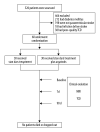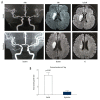Argatroban Increased the Basal Vein Drainage and Improved Outcomes in Acute Paraventricular Ischemic Stroke Patients
- PMID: 32667287
- PMCID: PMC7382300
- DOI: 10.12659/MSM.924593
Argatroban Increased the Basal Vein Drainage and Improved Outcomes in Acute Paraventricular Ischemic Stroke Patients
Abstract
BACKGROUND Since venous drainage in acute arterial ischemic stroke has not been thoroughly researched, we evaluate the effect of argatroban, a selective direct thrombin inhibitor, as a therapy to increase the rate of basal vein Rosenthal (BVR) drainage and improve patients' post-stroke outcomes. MATERIAL AND METHODS In this multicenter clinical trial, 60 eligible patients at 4.5 to 48 hours after the stroke onset were recruited. After being randomly allocated into 2 groups, they were treated with standard therapy either alone or with argatroban. RESULTS Compared to the contralateral brain hemisphere, the mean flow velocity (MFV) in BVR drainage was significantly reduced in the stroke-afflicted ipsilateral hemisphere. After treatment with argatroban for 7 days, the MFV from BVR of the ipsilateral hemisphere in the argatroban treated group was significantly increased when compared to the control group. At 90 days after the onset of stroke, the MFV of BVR in the ipsilateral hemisphere was similar in both groups. Compared with controls, the argatroban-treated patients had smaller lesions from baseline to 7 days. Argatroban also improved National Institutes of Health Stroke Scale (NIHSS) scores on day 7 after the onset of stroke. Furthermore, the argatroban group's neurological functions were superior to those of their untreated counterparts after 90 days. No difference was found in the incidence of adverse reactions between the 2 groups. CONCLUSIONS These observations indicate that vein drainage change may contribute to the acute phase of brain edema and the outcomes of ischemic stroke patients.
Conflict of interest statement
None.
Figures




References
Publication types
MeSH terms
Substances
LinkOut - more resources
Full Text Sources
Medical

